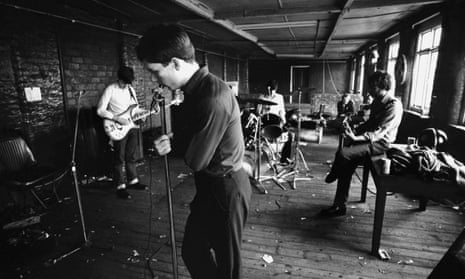In late 1978, when I was 13, I started a fanzine called Photophobia, about the independent music scene. It was photocopied and stapled together, and all written by me to begin with. I was a few years too young for punk, but fascinated by what followed, particularly bands from the north, where I lived: the Fall, Human League and Joy Division. The fanzine was a way to get closer to them, and articulate my feelings about this music I loved.
My friends and I used to go into Manchester at weekends. The addresses of our favourite labels were on the backs of their LPs, so we’d go and find the buildings; at weekend, they were always shut, but we didn’t care. We also went to TJ Davidson’s, where all the great bands rehearsed. It was an industrial building with no lift; the more successful the band, the lower down they played. We’d knock on the door and walk in. We saw the Fall, and Mick Hucknall with his first band, Frantic Elevators, and Joy Division (here, I’m sat at the back on the right, looking straight ahead).
Unknown Pleasures, their debut album, was released two months before this picture was taken, and although it hadn’t been rapturously received, the buzz around them was substantial. The popular image of the band was cold and detached: they rarely gave interviews, their music was sombre, and there are few colour photos of them, because magazines printed in black-and-white back then. Manchester in the late 70s was a pretty grim place; there was an air of melancholy.
In person, though, they couldn’t have been more different: they were down-to-earth, friendly and funny, and didn’t seem to mind a few teenagers watching them rehearse. It only strikes me now how young they were, just 22 and 23. Even at the time, we knew what a privilege it was. We watched them regularly after this. Nine months later, on 18 May 1980, Ian Curtis took his own life. For most of us, it was our first encounter with death, though the significance of it didn’t register with us at the time.
This series of photographs, by Kevin Cummins, are the most iconic taken of Joy Division. They were about to change the course of popular music. They were wildly original, like nothing else you’d ever heard. Seeing them live was a communal and transformative experience. They influenced so much of what was to come: it’s hard to imagine club culture, dance music, acid house, without them and New Order. Kevin understood this: by photographing them in this old Victorian building, like something out of a Lowry painting, he showed the tension between the past, present and future. For me, it’s nice to have photographic evidence of our presence. As Kevin wrote when he signed my copy of his book, Joy Division: “We were there.”
For me, these encounters with them laid the foundation for everything in my life: without this exposure to culture, I almost certainly wouldn’t have gone to art school or become a curator. Looking at this picture today, I feel so lucky to have grown up at that time; the barriers put up around bands today simply weren’t there then.

Comments (…)
Sign in or create your Guardian account to join the discussion